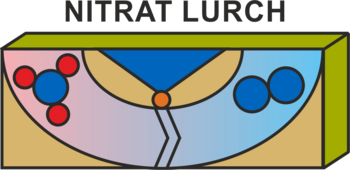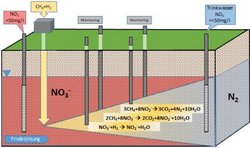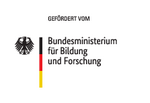Enhanced in-situ chemoautotrophic denitrification: flow-through tank experiments and field-site performance
de | en
In 2015, world leaders agreed to 17 Sustainable Development Goals (SDG). In this context the UN has recognized to tackle climate change and to improve water quality globally by 2030. SDG 6 aims to ensure that everyone has access to sustainably managed safe and clean water resources.
However, nitrate concentration in groundwater globally is often above the WHO drinking water limit of 50 mg/L, in part due to excessive use of fertilizers and manure when the land surface is intensively agriculturally used. Especially the effect of intensive livestock farming on drinking water quality has become a concern in the last decades. According to the 2012 status report of the European Environmental Agency (EEA), approximately 25% of all aquifers across Europe are in a poor chemical condition, for which nitrate contamination is mainly responsible 1.
The naturally occurring process of microbial denitrification can reduce dissolved nitrate (NO3-) in groundwater to harmless nitrogen gas (N2). In a large number of aquifers, however, this process may not occur over decades due to limited availability of electron donors such as dissolved organic carbon (DOC) 2. As a result, many former shallow drinking water wells were closed and water suppliers consider the use of deep groundwater as a way out of this predicament. The use of the latter one, however, is not sustainable since the groundwater recharge for deep aquifers is low and the water is often considered to be “fossil water”. In order to sustainably develop the use of shallow groundwater as drinking water resource, remediation technologies in addition to agricultural regulations are clearly needed.
At present there are relatively few options for nitrate removal available that are either costly or do not provide stakeholders appropriate quantities of clean drinking water.
This project will use a scaled approach to develop a new method for injecting electron donors in a gaseous form into the aquifer in order to enhance the natural remediation processes of microbial denitrification. Downstream of the injection well, the dissolved gases will be used by groundwater bacteria to remove nitrate and to provide water of drinking water quality. The project will scale up in multiple steps from laboratory scale experiments to a field scale demonstration project in cooperation with a local drinking water supplier. In the process, not only the chemical, microbiological, and hydrogeological parameters and biogeochemical processes in the aquifer will be determined and optimized but also the legal and legislative norms will be fulfilled and documented. The result is a widely applicable method for nitrate remediation that can readily be used in the future by other water suppliers or environmental agencies to provide affordable clean drinking water from a sustainable water source.
Responsible
Partners
Z-Design, Dipl.-Ing. Werner Zyla GmbH; BASE TECHNOLOGIES GmbH; Helmholtz-Zentrum für Umweltforschung GmbH – UFZ, Prof. Dr. Jan Fleckenstein; Universität Bayreuth (UBT), Prof. Dr. Tillmann Lüders
Project duration
01.03.2023 - 01.03.2026





